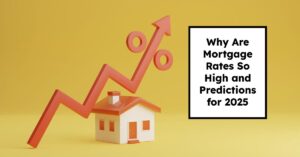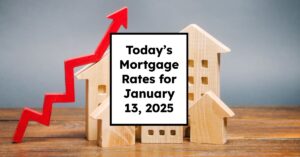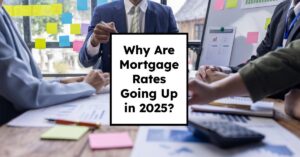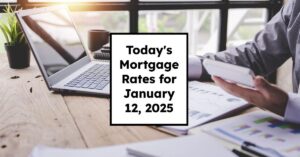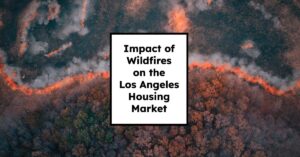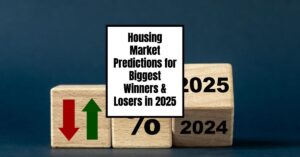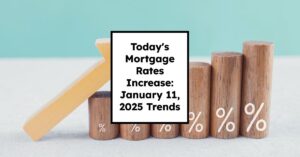Mortgage rates remain stubbornly high due to persistent inflation concerns and economic factors, and 2025 may not offer much relief for homebuyers. As we transition into a new year, many potential buyers are left wondering why mortgage costs are still elevated and what the future holds for these rates. Unfortunately, data suggests that while rates may hover below current levels, they are unlikely to experience a drastic decrease.
Why Are Mortgage Rates So High and Predictions for 2025
Key Takeaways:
- Current Status: Mortgage rates have stayed well above 6% in 2024, frustrating homebuyers.
- Main Influencer: Rates are heavily influenced by 10-year Treasury bond yields, which remain elevated due to inflation fears.
- Economic Factors: A strong job market and proposed policies could keep rates high.
- Predictions for 2025: Experts forecast 30-year fixed rates averaging between 6.2% to 6.6% for the year, which is still high compared to previous years.
The Current State of Mortgage Rates
Mortgage rates have indeed been a topic of concern for many looking to buy a home. As of early January 2025, the average rate for a 30-year fixed mortgage is around 7.11% according to recent data at Mortgage News Daily. This figure is frustrating for potential buyers hoping for a more favorable borrowing environment.
Despite the Federal Reserve's efforts to cut interest rates on loans and credit cards, mortgage rates haven’t budged significantly. This resistance to lower borrowing costs is frustrating for buyers who were hoping for a break in the housing market. Instead, mortgage rates closely follow the 10-year Treasury bond yields—a benchmark that lenders use to determine long-term borrowing costs—rather than directly responding to the Fed's adjustments.
Understanding Mortgage Rates
To understand why mortgage rates are so high, it's essential to understand how they are set. Lenders evaluate a variety of factors when determining mortgage rates, including:
- Cost of Borrowing: Banks and lenders borrow money themselves, and the rates they pay to borrow influences the rates they pass on to consumers. If banks are paying higher interest rates, they will likely charge higher rates to mortgage borrowers.
- Economic Indicators: Mortgage rates are influenced by various economic indicators, including inflation rates, employment levels, consumer confidence, and the overall economic growth. For instance, a strong job economy often leads to higher rates as consumer spending increases demand for goods and services, pushing prices higher.
- Credit Market Conditions: When investors feel uncertain about the economy, they may prefer to hold onto safer investments, such as government bonds. This can lead to increased yields on those bonds, thus raising mortgage rates as lenders attempt to offer competitive returns.
Why Are Mortgage Rates So High?
- Inflation Concerns: One of the driving factors for maintaining high mortgage rates is ongoing inflation. A robust economy paired with expectations of substantial deficit spending has kept investors wary. They seek higher returns on bonds, which directly impacts the yield and subsequently mortgage rates. Doug Carey, a chartered financial analyst, points out that proposed tariffs could exacerbate inflation further, making it challenging to expect lower rates soon.
- Economic Policies: Policies shaping the economic landscape, particularly those under the incoming administration, could contribute to the persistence of high rates. Expectations of increasing tariffs can fuel inflation, maintaining upward pressure on mortgage rates. As noted by financial experts, such changes could lead to rates remaining above 6% for an extended period.
- Market Expectations: High levels of uncertainty in the economic environment have made investors cautious. Consequently, they demand higher returns on investments, which inevitably filters down to consumers through increased lending costs. As a counteraction to inflation fears, mortgage lenders have adjusted rates upwards, further complicating the homebuying process.
- Geopolitical Factors: International issues also influence mortgage rates. For example, ongoing trade tensions, geopolitical strife, and changes in global economic conditions can lead to fluctuations in interest rates. Investors often react to these uncertainties by shifting their investment strategies, which can further affect bond yields and mortgage rates.
What to Expect for Mortgage Rates in 2025
Looking ahead, the projections for mortgage rates in 2025 indicate that the situation might not change dramatically. Experts from reputable finance institutions have released forecasts that present a somewhat grim picture for hopeful buyers:
| Institution | Forecasted Rate |
|---|---|
| Mortgage Bankers Association | 6.4% to 6.6% |
| Realtor.com | ~6.2% |
| Fannie Mae | Average of 6.4% |
| Wells Fargo | ~6.3% |
| Goldman Sachs | Above 6% |
These figures reveal a consensus among economists and financial institutions that mortgage rates will likely remain above 6% throughout 2025. The anticipated marginal decrease is overshadowed by the underlying economic pressures that continue to fuel higher rates.
The Impact of Economic Policies and Employment Figures
As we assess the landscape of mortgage rates, it's crucial to consider the broader economic indicators, mainly employment rates and government policies. The Federal Reserve's decisions are often swayed by current job market conditions. A robust job market can signal economic strength but may also lead to sustained inflationary pressures.
Speculatively looking at the employment figures, if the job market continues to thrive without signs of significant slowdown, there may be inward pressure on interest rates. This dynamic may contribute to keeping mortgage rates elevated as lenders adapt to perceived risks in the economy.
Moreover, government spending and fiscal policy decisions can also shape mortgage rates. If the government decides to spend more on infrastructure or public services, it may boost employment and economic activity. While this can be beneficial overall, it might also contribute to inflation spikes, prompting the Federal Reserve to adjust interest rates accordingly.
Market Sentiment and Future Outlook
Market sentiment is another significant driver of mortgage rates. If buyers remain hesitant due to high rates, homes may linger on the market longer, prompting sellers to adjust prices. However, this adjustment is not always sufficient to compensate for current borrowing costs, leading to a strained and stagnated housing market.
Consumer confidence plays a critical role as well; as buyers perceive higher rates as unmanageable, they may decide to forego home purchases, creating a ripple effect throughout the housing market. Understanding this sentiment can provide insights into the overall direction of mortgage rates moving forward.
In essence, the prevailing attitudes in the marketplace can create volatility. If potential buyers sense a downturn or uncertainty, they may withdraw from making purchases. This can lead to a situation where demand decreases, but supply remains constant or increases, leading to downward pressure on home prices if sellers lower expectations. Nevertheless, if interest rates remain high, prospective buyers may still find it challenging to enter the market, maintaining a delicate balance.
Recommended Read:
Mortgage Rate Predictions January 2025: Forecast for Homebuyers
Mortgage Rates Rise to the Highest Level Since July Last Year
Economic Forecasts from Reputable Institutions
In addition to the experts outlined earlier, other notable institutions have provided insights into the expectations for mortgage rates in 2025. For instance, the National Association of Home Builders (NAHB) has also weighed in with predictions that the 30-year fixed mortgage rate will hover around 6.36% throughout the year. They noted that this reflects a continuity of the present landscape rather than a dramatic shift.
Similarly, a report from Freddie Mac projected that mortgage rates would likely stabilize at elevated levels, maintaining a range that could push home affordability further out of reach for many Americans. The expectations of 6% rates are not merely figures but a reality check for homebuyers entering the market.
Impact on Homebuyers and the Housing Market
The implications of high mortgage rates on potential homebuyers cannot be understated. With rising costs, many buyers are faced with difficult decisions and may need to adapt their expectations. For first-time homeowners and families looking to upgrade or change their living situation, the obstacle of securing an affordable mortgage adds layers of complexity to the homebuying journey.
The impact on the housing market includes the potential for decreased sales volume, leading to a slower market pace. High rates can discourage both first-time buyers and current homeowners looking to sell. This dynamic can lead to stagnation within the market, as fewer transactions typically correlate with homes remaining on the market for longer periods.
Navigating the High Rate Environment in 2025
As we move into 2025, buyers and those in the real estate industry will need to navigate a high-rate environment with a strategic approach. For some, this may mean adjusting their budget—considering homes that are priced lower than originally planned or looking into different markets. Sellers may also need to be mindful of current financing costs in their pricing strategies, involving a careful consideration of how high rates affect buyer purchasing power.
Furthermore, some may explore adjustable-rate mortgages (ARMs) as an alternative. While ARMs can be subject to fluctuations, they might offer lower initial rates compared to fixed-rate mortgages. Understanding different types of mortgages will be crucial for buyers aiming to find the best financing options.
In conclusion, while it may feel discouraging for potential homebuyers anticipating lower mortgage rates, the current economic indicators suggest that 2025 will continue to present challenges in the form of elevated borrowing costs. The intricate web of economic factors, market sentiments, and government policies plays a pivotal role in shaping the mortgage landscape.
As we anticipate the year ahead, individuals must stay informed and be proactive about their options as they navigate the complexities of the housing market in 2025.
Work with Norada in 2025, Your Trusted Source for
Real Estate Investing
With mortgage rates fluctuating, investing in turnkey real estate
can help you secure consistent returns.
Expand your portfolio confidently, even in a shifting interest rate environment.
Speak with our expert investment counselors (No Obligation):
(800) 611-3060
Recommended Read:
- NAR Predicts 6% Mortgage Rates in 2025 Will Boost Housing Market
- Mortgage Rates Predictions for 2025: Expert Forecast
- Half of Recent Home Buyers Got Mortgage Rates Below 5%
- Mortgage Rates Need to Drop by 2% Before Buying Spree Begins
- Will Mortgage Rates Ever Be 3% Again: Future Outlook
- Mortgage Rates Predictions for Next 2 Years
- Mortgage Rate Predictions for Next 5 Years
- Prediction: Interest Rates Falling Below 6% Will Explode the Housing Market
- Mortgage Rate Predictions: Why 2% and 3% Rates are Out of Reach
- How Lower Mortgage Rates Can Save You Thousands?
- How to Get a Low Mortgage Interest Rate?
- Will Mortgage Rates Ever Be 4% Again?
